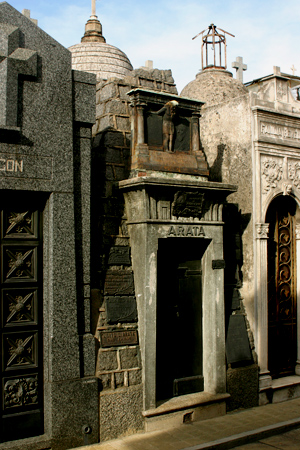
A little bit of Egypt in Argentina, several members of the Arata family are buried here but none as recognized as Pedro Narciso Arata. The unfinished pyramid implies the same symbolism as a truncated column: a life ended with many tasks undone.
Freemason fanatics shouldn’t get too excited; Arata died the same year that Tutankhamun’s tomb was discovered (1922) & Egyptian design had become fashionable… but yes, he was also a member of the Masonic Society. So maybe a double meaning here? Let’s examine his life.
Born in Buenos Aires in 1849 & related to the wealthy Unzué clan, Arata’s early years of school were in Paris. Naturally. He returned to Argentina for high school & university, tutoring many of his classmates in science including future President Roque Sáenz Peña. Arata quickly became part of the scientific elite & enrolled in medical school while teaching at the Faculty of Exact Sciences. Combining his knowledge chemistry & medicine in the improvement of city hygiene, Arata created the Municipal Chemical Office in 1883:
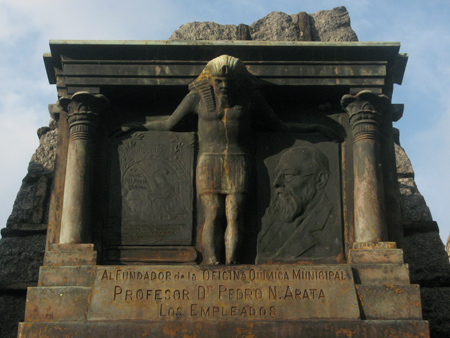
On closer inspection, the left side reveals a faint image of a woman & child doing some sort of chemistry with a snake eager to participate. Crudely etched on the the bottom is a Latin phrase “Alii quidem equos am ant, alii oves, alii feros; mihi vero a puerulo mirandum acquirendi et possidendi libros insedit desiderium.” Fourth century Roman emperor Julian placed this quotation over every library he opened & obviously refers to Arata’s work to expand the University of Buenos Aires:
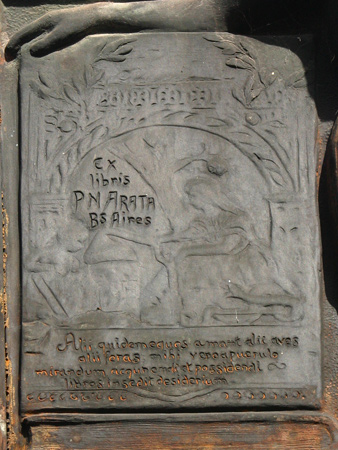
Arata became Dean of the School of Agriculture & Veterinary Sciences (Facultad de Agronomía) in 1904. His massive library of 40,000 books eventually became part of the university’s collection & a train station named after him greets students today. The campus occupies a huge section of the city, complete with horses & llamas:
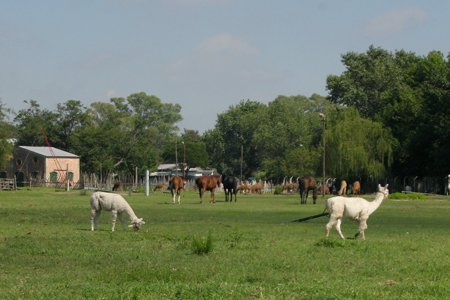
For all his accomplishments, Arata’s political beliefs tended toward the conservative as evidenced by a dedicatory plaque from the Liga Patriótica Argentina… so maybe there is a bit of Masonic influence in the design after all:
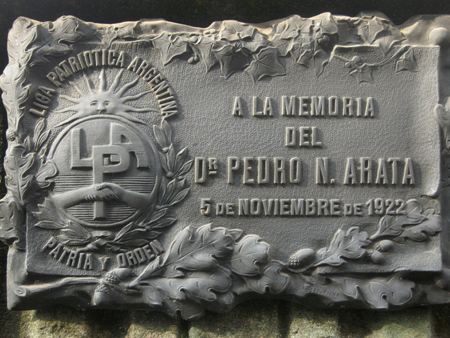
Existen claras evidencia de la pertenencia de este personaje a la masonería.
Como la mayoría en el cementerio!
I was investigating more and in the Agricultural College of UBA there is a library with the name of Arata.
Here is the link
https://www.agro.uba.ar/en/biblioteca-arata
There they refer to the Latin phrase you mention (there is even a picture)
La inscripción de la lámina dice: “Alii quidem Equus amant, alii aves alii feras; mihi vero a puerulo mirandum acquirendi et posidendi libros insedit desiderium.” (“Pues algunos aman los caballos y otros los pájaros, otros las fieras, en cambio de mí se posesionó desde chico el deseo ferviente de adquirir y poseer libros”).
Excellent work! I wish the photo was larger so I could post it here… It says that Julian the Apostate put this phrase on a library he founded in 361 in Antioch. Arata knew who to copy 🙂
Hola , me han informado que mi bisabuela ( Rosa Maria Bale ( Martha Moltedo ) ) esta en esta bóveda…como se podra obtener mas informacion ?? Gracias
Hola Solange – La única forma de obtener más información sobre tu bisabuela es ir al cementerio. Con la fecha de su fallecimiento, podés buscar en los archivos y ver donde está enterrada. Saludos!